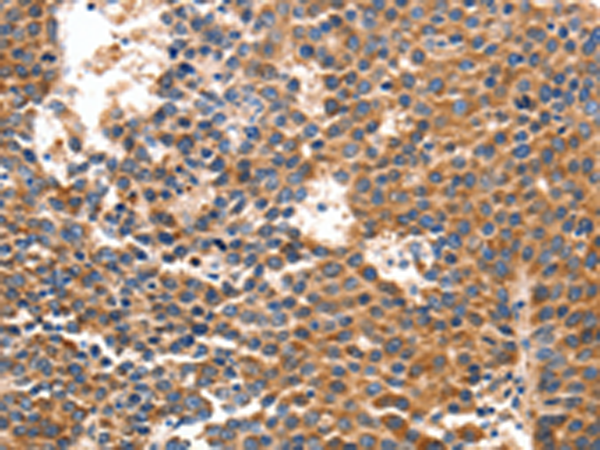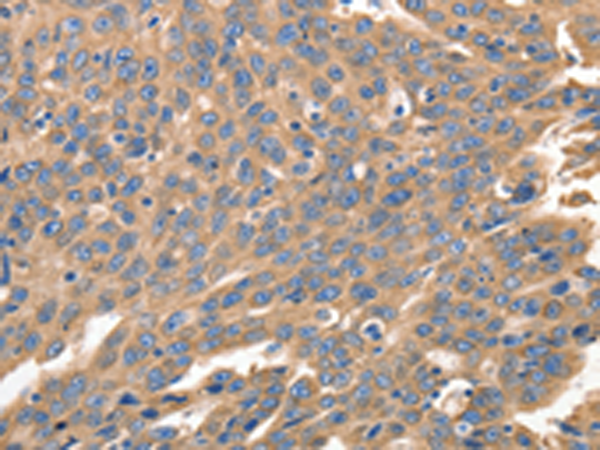


| WB | 咨询技术 | Human,Mouse,Rat |
| IF | 咨询技术 | Human,Mouse,Rat |
| IHC | 1/50-1/200 | Human,Mouse,Rat |
| ICC | 技术咨询 | Human,Mouse,Rat |
| FCM | 咨询技术 | Human,Mouse,Rat |
| Elisa | 1/2000-1/5000 | Human,Mouse,Rat |
| Aliases | MAR, IRF-1 |
| WB Predicted band size | 37 kDa |
| Host/Isotype | Rabbit IgG |
| Antibody Type | Primary antibody |
| Storage | Store at 4°C short term. Aliquot and store at -20°C long term. Avoid freeze/thaw cycles. |
| Species Reactivity | Human, Mouse, Rat |
| Immunogen | Synthetic peptide of human IRF1 |
| Formulation | Purified antibody in PBS with 0.05% sodium azide and 50% glycerol. |
+ +
以下是3篇关于IRF1抗体的参考文献示例(内容为模拟概括,仅供参考):
---
1. **"IRF1 mediates the antiviral response by regulating interferon-stimulated genes"**
*作者:Tanaka N, Kawakami T*
摘要:研究利用IRF1特异性抗体通过Western blot和免疫荧光技术,证实IRF1在病毒感染后显著上调,并调控下游干扰素相关基因的表达,揭示其在先天免疫中的关键作用。
2. **"Epigenetic regulation of IRF1 in tumor suppression"**
*作者:Harada H, Willison KR*
摘要:通过ChIP实验(使用IRF1抗体)结合测序分析,发现IRF1在多种癌症中通过结合抑癌基因启动子区域抑制肿瘤生长,为癌症治疗提供潜在靶点。
3. **"IRF1 and STAT1 synergy in inflammatory signaling"**
*作者:Mamane Y, Sharma S*
摘要:研究采用IRF1抗体进行免疫共沉淀和凝胶迁移实验(EMSA),证明IRF1与STAT1在炎症反应中形成复合物,协同激活促炎细胞因子表达。
---
注:以上文献信息为示例性概括,实际引用需以真实文献为准。如需具体文章,建议通过PubMed或Google Scholar以“IRF1 antibody application”等关键词检索。
The interferon regulatory factor 1 (IRF1) antibody is a key tool for studying the role of IRF1. a transcription factor critical in immune regulation and cellular stress responses. IRF1. a member of the IRF family, is activated by interferons (IFNs), cytokines, and pathogens, and functions as a mediator of innate and adaptive immunity. It binds to interferon-stimulated response elements (ISREs) in promoter regions to regulate genes involved in MHC class I antigen presentation, antiviral defense, apoptosis, and tumor suppression. IRF1 also interacts with signaling pathways like JAK-STAT and NF-κB, modulating inflammatory responses and cell cycle control. Dysregulation of IRF1 is linked to autoimmune diseases, cancer progression, and viral evasion mechanisms.
IRF1 antibodies are widely used in techniques such as Western blotting, immunohistochemistry, and chromatin immunoprecipitation (ChIP) to evaluate IRF1 expression, localization, and DNA-binding activity. These antibodies help characterize IRF1's role in immune cell differentiation, tumor microenvironment modulation, and host-pathogen interactions. Specific clones (e.g., D5E4. EP1558Y) and host species (rabbit, mouse) are validated for sensitivity and specificity, often using IRF1-knockout controls. Researchers employ IRF1 antibodies to explore its dual role as a tumor suppressor or oncogene, depending on cellular context, and its potential as a therapeutic target or diagnostic biomarker in diseases like leukemia, chronic inflammation, and viral infections.
×